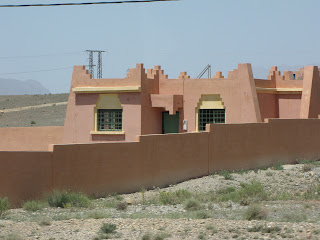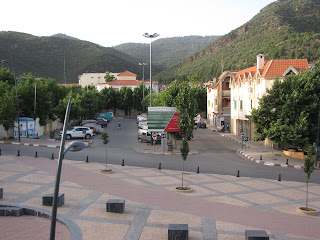We managed to get onto a bus that was leaving at about 9.30 and there was plenty of room. Quite a lot of the women on the bus had tattoos on their forehead and between the nose and lip. It is supposed to protect them from evil spirits. The Berber women don't wear veils but do have a headscarf.

We climbed up through the Middle Atlas mountains that became drier and rockier. The Ziz gorge was pretty spectacular and the road thankfully, in great condition.
We arrived at the bus station in Er Rachidia and tried a budget hotel that was recommended in our guide book. It was disgusting, so found a cleaner and more comfortable one near the bus station. Straight across the street was a cafe where we ordered a chicken salad. The place was not only a cafe but also a restaurant and brand new hotel. The manager was keen to show us the place and informed us that it had not had one guest yet and was probably hoping that we would be his first ones.
Er Rachidia is a popular stop for visitors who go onto visit the 150m high sand dunes in Merzouga near the Algerian border. The border between the two countries is closed. The town was established by the French as a regional capital where they had their Foreign Legion fort. It still has huge areas of military barracks.

Pink seems to be a favourite colour to paint building both in the country and in the city. Some of the design features are often painted in contrast colours and bricks in the traditional step design add a pattern to the otherwise plain roof.
 Some places are elaborately decorated.
Some places are elaborately decorated.We arrived at Ouarzazate and got a petit taxi to the main square where we checked into a hotel overlooking it. It was the middle of the day and pretty hot and there was hardly anyone in the square. As the day cooled more and more people came out and as the sunset the stall holders came on force to set up. There were lots of stalls with second hand clothing and shoes as well as the usual Chinese plastic houseware. Some men had bits of wire and old tools while others had boxes of brand new juicers, blenders, pressure cookers and coffee makers. Families flooded the place with babies in strollers and never left until about 1am.
Our room had no fan or air con and we had to keep our window open and it was difficult to sleep with so much racket. Moroccan children don't just cry when they are unhappy or don't get their own way. They have this infuriating habit of crying and then follow it with a high pitched long loud squeal. It goes on and on and the parents don't seem bothered by it. It's torture when there are two or three of them in your bus!

From our hotel we could see the piles of traditional cooking dishes called tagines.

We set off after one night and got another bus to take us back to Marrakech through interesting terrain.

There are numerous kasbah between here and Marrakech. They are essential fortified tribal villages. They are well decorated and look like giant sandcastles. Some are over 100 years old and need a lot of maintenance as the rain erodes the walls. Many are used as hotels.
The Ouarzazate region has been the film set for many movies including, Lawrence of Arabia, Alexander the Great, Gladiator, and Black Hawk Down to name a few. From the bus we saw the Atlas Film Corporation Studios and at a major roundabout in the city there is a model of a giant film reel.

We drove alongside many palmeries that ran for kilometres in the valleys. In these oases settlements, small holding farmers may have about thirty palms per family and in a good year can produce a thousand kilos of dates; the market rate is about $1NZ per kilo. Unfortunately the effect of drought and the Bayoud fungal disease have a caused a lot of problems for the families here.

Our bus with air con that worked reasonably well.
We stopped in front of this shop/restaurant. Passengers got out and bought goat meat from the butcher next door and then gave it to the cook. He put the meat in a wire grill and fanned his charcoals into action. None of the targines sitting on their small charcoal holders were ready so I guess they would be for the evening meal.
In the towns and along the roadsides there are tables set out with geode, ammonites, and trilobites for sale.

As we got closer to Marrakech there were more wildflowers and this valley was attractive with its oleanders in flower.
Watermelons and cantelopes for sale on the outskirts of Marrakech.
We headed back to spend a few days in Anette's aprtment in M'hamid to get ready to walk in the Atlas mountains now that we are cough free again.
























